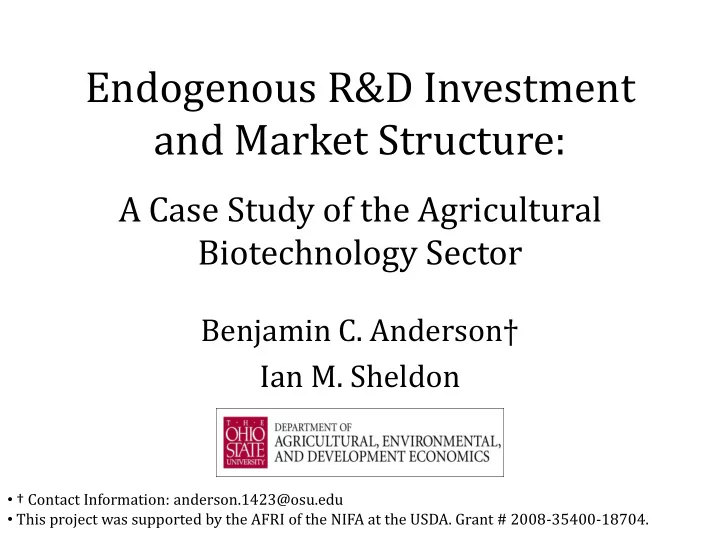

Endogenous R&D Investment and Market Structure: A Case Study of the Agricultural Biotechnology Sector Benjamin C. Anderson† Ian M. Sheldon • † Contact Information: anderson.1423@osu.edu • This project was supported by the AFRI of the NIFA at the USDA. Grant # 2008-35400-18704.
Motivation • Why agricultural biotechnology? – Young (dynamic) industry – Property rights – Increasing importance in global agriculture • Why an endogenous fixed cost (EFC) model? – Product quality and sunk investments in R&D – Levels of industry concentration bounded away from perfect competition
Research Questions • Is the agricultural biotechnology industry, specifically the GM corn seed industry, characterized by an EFC-type model? • How is this analysis relevant to: – Past consolidation activity – Current discussions on anticompetitive actions – Implications on future sector growth
The Agricultural Biotechnology Sector • The seed industry before biotechnology – Innovation, IPRs, and patenting – Mendelian genetics and hybridization • Consolidation and concentration: the first generation of commercialized GM crops • Subsequent generations and renewed concerns of concentration
Data • R&D Concentration – APHIS Field Trial Data on applications (6697) for the release of GM crops (1990-2010) – Dates, phenotypes/genotypes, states – Petitions for deregulation (heterogeneity) • Market Size – NASS Acreage Reports (1996-2010) – “Adoption of Genetically-Engineered Crops”, ERS data product (2000-2010)
Market Definition • Share of total corn acres planted • Share of corn acres planted to total cropland • Herbicide Use – % of corn acres treated – Intensity of application (lb/acre) • Pesticide Use – % of corn acres treated – Intensity of application (lb/acre)
Market Definition Figure 3: Core and Fringe Regions of the US Corn Belt (Regional Share of Total Corn Acres Planted) Northeast North (0.2%) %) “Fringe” (20.6%) Mid-Atlantic (4.2%) “Core” West East (29.5%) (3.4%) West “Fringe” “Fringe” (15.2%) (19.1%) Appalachia (2.2%) Southern Southeast Plains Legend (1.6%) (4.0%) ( - ): Regional Share of US Corn Acres Planted (2010) Source: Authors’ calculations from NASS 2010 Acreage Report.
Empirical Model • Sutton (1991, 1998) – Ellickson (2007), Berry and Waldfogel (2006), Marin and Siotis (2007), Dick (2007) 𝐷 1 ≥ 𝑏 0 • Theoretical prediction: 𝛾 ∗ ∙ ℎ 𝑙 0 • Empirical model: 𝛾 1 𝑜 ℎ + 𝜁 𝑗 , 𝐷 𝑗 = 𝛾 0 + ln 𝑇 𝐺 0 𝜒 – where 𝜁−𝜈 , 𝜒 , 𝜀 > 0 . 𝐺 𝜁 = 1 − exp − 𝜀
Concluding Remarks • Supportive evidence for agricultural biotechnology being characterized by EFC • Going forward: – Refining markets – Estimating model accounting for specific product traits – Comparison with other GM seed industry markets (soybeans/cotton)
Recommend
More recommend